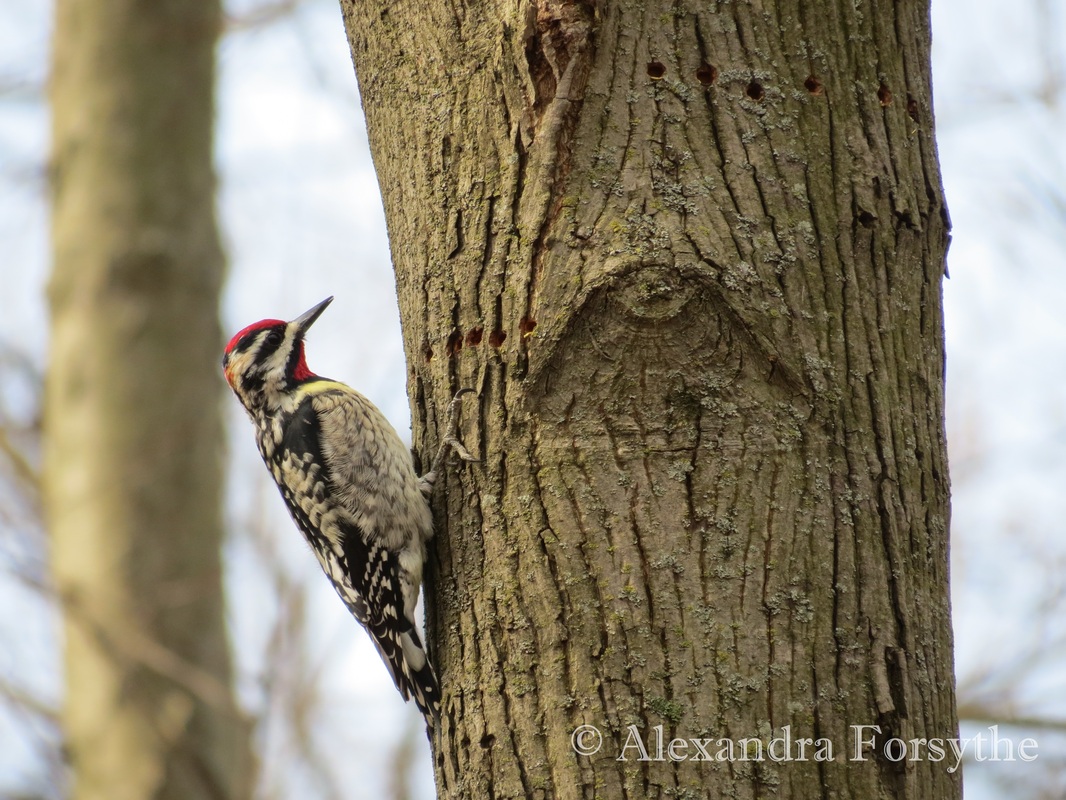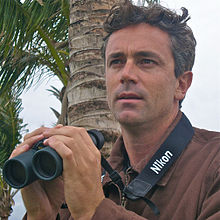“You Yellow-bellied Sapsucker!” Is that a compliment or insult? Yosemite Sam used the term “Yellow-bellied Sapsucker” to describe Bugs Bunny, and judging from the results of my research, that was a big insult! The Yellow-bellied Sapsucker was once thought to be a blight and an enemy of humans.
I came across the minutes of the Indiana State Horticultural Society meeting held in January of 1871. The purpose of the meeting was to discuss the best way to deal with the sapsuckers, woodpeckers and other birds that were blamed for the damage caused to fruit trees. Most of the speakers believed the best and only effective method was to shoot the birds on sight. Reading their angry comments, you could sense how deeply they hated sapsuckers! However, the group’s vice-president, J. C. Ratliff, went against the majority and spoke eloquently in favor of protecting the sapsucker and all other birds. He felt that the birds were beneficial, and eradicating them would cause more harm than good.
Ratliff stated, “No fruit grower need be told that his losses in the failure of his crops can be attributed more to the ravages of insects than from all other causes. Human agency can accomplish but little in the destruction of insects unassisted by the various means which nature has provided for that purpose. I think we can accomplish more by protecting insectivorous birds and animals than our most approved method of warfare... I will venture to advance the theory that... nature employs the sapsucker to perform an important office... I will again quote from [an unnamed natural history treatise]: ‘Of all the birds of this species none rid the apple trees of so many vermin as this, digging off the moss, and probing every crevice. His industry is unequaled and almost incessant. I consider the sapsucker my friend, consequently do neither kill him nor allow him killed on my premises.’”
Despite Ratliff’s eloquence, his fellow board members remained unconvinced but open to further study and future discussions. The Migratory Bird Act was passed in 1918, forty-five years after the heated debate of the Indiana State Horticultural Society and Mr. Ratliff’s impassioned plea.
Today, we know that Yellow-bellied Sapsuckers are beneficial birds. Yes, they dine on sap, but they also consume insect pests and provide much-needed, ready-made meals for other migratory birds such as warblers.
To get to the sap for which they were named, a Yellow-bellied Sapsucker will drill neat rows of horizontal holes as sap wells (shown in the photo). The sapsucker will also drill two kinds of wells: round-shaped wells for a single use, and square-shaped wells for continuous use. Other birds such as chickadees, hummingbirds, and warblers, along with many other kinds of animals, will feed from the sap that oozes from the wells. The sap will also attract insects which are eaten by several types of birds.
The sap that the sapsuckers eat is not the same sap that we use to make maple syrup. The sapsuckers drill very shallow holes to reach the phloem sap, while humans drill deeply into trees to reach the xylem sap. The watery xylem sap contains only 2-3% sugar but it is more free-flowing, allowing humans to collect more in a shorter amount of time. The sapsucker prefers the phloem sap which contains 20-30% sugar, but contains less water and is therefore more gelatinous. Because the sap is so difficult to get out of the tree, the sapsucker has evolved a fuzzy, specialized tongue that is hairy like a brush to collect the sap.
So, is it an insult to be called a Yellow-bellied Sapsucker? No! It is a compliment! The sapsucker is a hard-working, wonderful, beneficial bird that helps many other species, including humans, directly and indirectly.
I came across the minutes of the Indiana State Horticultural Society meeting held in January of 1871. The purpose of the meeting was to discuss the best way to deal with the sapsuckers, woodpeckers and other birds that were blamed for the damage caused to fruit trees. Most of the speakers believed the best and only effective method was to shoot the birds on sight. Reading their angry comments, you could sense how deeply they hated sapsuckers! However, the group’s vice-president, J. C. Ratliff, went against the majority and spoke eloquently in favor of protecting the sapsucker and all other birds. He felt that the birds were beneficial, and eradicating them would cause more harm than good.
Ratliff stated, “No fruit grower need be told that his losses in the failure of his crops can be attributed more to the ravages of insects than from all other causes. Human agency can accomplish but little in the destruction of insects unassisted by the various means which nature has provided for that purpose. I think we can accomplish more by protecting insectivorous birds and animals than our most approved method of warfare... I will venture to advance the theory that... nature employs the sapsucker to perform an important office... I will again quote from [an unnamed natural history treatise]: ‘Of all the birds of this species none rid the apple trees of so many vermin as this, digging off the moss, and probing every crevice. His industry is unequaled and almost incessant. I consider the sapsucker my friend, consequently do neither kill him nor allow him killed on my premises.’”
Despite Ratliff’s eloquence, his fellow board members remained unconvinced but open to further study and future discussions. The Migratory Bird Act was passed in 1918, forty-five years after the heated debate of the Indiana State Horticultural Society and Mr. Ratliff’s impassioned plea.
Today, we know that Yellow-bellied Sapsuckers are beneficial birds. Yes, they dine on sap, but they also consume insect pests and provide much-needed, ready-made meals for other migratory birds such as warblers.
To get to the sap for which they were named, a Yellow-bellied Sapsucker will drill neat rows of horizontal holes as sap wells (shown in the photo). The sapsucker will also drill two kinds of wells: round-shaped wells for a single use, and square-shaped wells for continuous use. Other birds such as chickadees, hummingbirds, and warblers, along with many other kinds of animals, will feed from the sap that oozes from the wells. The sap will also attract insects which are eaten by several types of birds.
The sap that the sapsuckers eat is not the same sap that we use to make maple syrup. The sapsuckers drill very shallow holes to reach the phloem sap, while humans drill deeply into trees to reach the xylem sap. The watery xylem sap contains only 2-3% sugar but it is more free-flowing, allowing humans to collect more in a shorter amount of time. The sapsucker prefers the phloem sap which contains 20-30% sugar, but contains less water and is therefore more gelatinous. Because the sap is so difficult to get out of the tree, the sapsucker has evolved a fuzzy, specialized tongue that is hairy like a brush to collect the sap.
So, is it an insult to be called a Yellow-bellied Sapsucker? No! It is a compliment! The sapsucker is a hard-working, wonderful, beneficial bird that helps many other species, including humans, directly and indirectly.


 RSS Feed
RSS Feed
